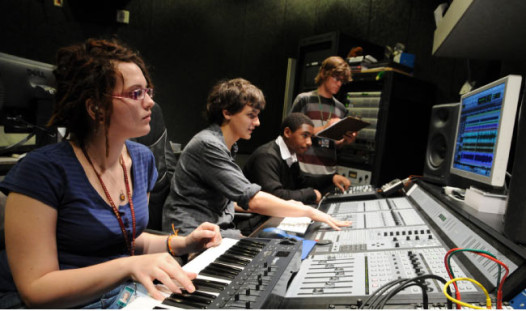Editor’s note: In a series last fall called Voices from the Classroom: The Arts in Education Reform, NolaVie and cultural partner WWNO public radio teamed up to take a look at how the arts are being used creatively in schools around the city. With the start of a new school year, and education in New Orleans a more vital topic than ever, we are reposting stories from the series. In this installment,NolaVie editor Renee Peck looks at a pioneer in the local arts movement.
Audio PlayerArts education is getting new emphasis across the country, but here in New Orleans it’s hitting middle age. The New Orleans Center for Creative Arts turned 40 this year. The school has students from 17 Louisiana parishes learning everything from the culinary arts to video production. Its prestigious alumni include names like Branford Marsalis, Harry Connick Jr. and Wendell Pierce.
For NOCCA president andCEO Kyle Wedberg, the rest of the world is simply catching up with what they’ve been doing for decades. When the school was founded in 1973, the idea was to consolidate arts education in a central location to serve the entire community.
“The original mission of NOCCA was to take what would be tip-of-spear talented training in the arts and make it available to students from every high school in Orleans Parish,” Wedberg explains. “By consolidating it you could do more than by trying to replicate it in 10 different high schools around the city.”
Fine arts training was a popular educational platform in the ‘70s, with cities across the South creating similar institutions. Then the arts emphasis fell by the wayside for a few decades, before making a recent comeback in educational circles.
“It’s fun for me to hear current educational thinking focus on what they now call 21st century skills,” says Wedberg, “which they used to call soft skills, which before was just an expectation of everyone entering the work force. And they’re all arts skills.”
Four years ago, NOCCA went the arts-integration movement one better: It integrated academics into the curriculum, giving students the option of a full-day program of core subjects as well as arts. The first full-day NOCCA class will graduate this May.
“One of things that had happened in a post-Katrina New Orleans is that there were a lot of people who were purporting to be able do a good job in educating our students,” Wedberg explains. “Even though NOCCA had only done half the day for most students, they had done an extraordinary job with that half day.”

Students today have to be adaptive, says Wedberg, as jobs, and technology evolve.
From the onset, the core curriculum at NOCCA was based on what the school had always done best.
“Instead of buying a stack of textbooks off of shelves somewhere, we decided to design our own curriculum. We used ourselves as a model, and then we went out into the world and looked at educational and organizational models. Everything from higher education in MIT and Cal Arts to Google and Youtube to High Tech High in San Diego. We looked at different places and absolutely positively stole elements from places that had already figured out how to do this well.”
The result was a document outlining the design principles for the school’s new academic offerings – what Wedberg calls their DNA.
“Inside of that are things like ability to get critique, ability to work in ensemble, a work ethic, having an opinion and a personal aesthetic — things that, if you are an employer, employers will say we can train anyone to do these things, this job’s skills, but the 21st century skills, that’s the stuff we don’t have time to get someone up and ready to do. So we know as thoughtful educators and adults, that some high percentage of our students within the next decade or two are going to have jobs that don’t currently exist. We don’t know what they’ll be doing as a living and a career, even as an artist.”
The idea of using an arts education model to teach other subjects appeals to Wedberg.
“Our educational pedagogical model is 120 years behind the times in all the right ways,” he says with a smile. “It is not until the end of your training in traditional education that you work with the person who does what you purport to want to do. Law school, medical school. At the end of a path you finally get to that artist-apprentice model. Our students do that at 14. They work side by side with someone who is a practicing visual artist, someone who is hanging the lights at Mahalia Jackson … It demystifies it.”
And the arts, says Wedberg, make a pretty good platform for learning life skills.
“What I counsel families on, is at no point will your child say it’s just a shame that I can stand in front of an audience, that I’m good on my feet, that I can stand and deliver, that I’m good in a group, that I can tell people what I think and accept what they think. Those are skills that will be good in whatever they choose to do and make them a leader in whatever they choose to do. For us, the education in the arts, the thinking like an artist, the skills of being an artist, will translate.”

NOCCA will graduate its first class of full-curriculm students in May.
There’s no academic test for entrance to NOCCA. Students who pass the required arts audition and opt for the full-day option are put into a lottery. So far, with 250 students and a capacity for 280, everyone has managed to get a place.
The core classes at NOCCA – math or biology or English – don’t look that different from their counterparts elsewhere. As Wedberg puts it, a Bunsen burner is a Bunsen burner. But what happens in those classrooms definitely reflects the artistic environment.
“The students’ curiousity is met and expanded by our faculty. Honestly, student initiative has led to changes in our curriculm and vise versa. That’s the beautiful thing about working with artists. They are constantly looking at things and trying to reinvent them. It’s not a widget factory.”
Wedberg recalls one student who choreographed a dance around Neanderthals. “He said very plainly that it had been something that had been in his mind since his humanities class his freshman year. It was a beautiful piece that he wouldn’t otherwise have had floating around.”
Ninety-seven percent of NOCCA’s students go on to college. Last year, they earned $17.4 million in scholarships. Two-thirds of them enter college thinking they will work as artists, but that number drops as the rigors of school and realities of life intervene. Still, says Wedberg, students with artistic foundations are the ones who will maintain the culture in decades to come.
“Having arts has a demander and a consumer base,” he points out. “So those who come through NOCCA and have a high level of training, those that become doctors and lawyers, will be those who also are serving with Carol [Bebelle’s] board at Ashe [Cultural Center], with the LPO. They’re the ones who will be the high demanders and leveragers of arts for this community. So it has returns well beyond just careers.”
Even those who do choose careers in the arts must be flexible, Wedberg says.
“In the arts, careers look wildly different now than they did 50 years ago, and they looked wildly different 50 years ago than 50 years before that. Their abilities to adapt are going to be needed for whatever career they have, in the arts or outside of them. These are skills that will be incredibly useful to them in any of those aspects.”
Ultimately, it’s all about creativity – in the teacher, in the discipline, in the child.
“Daniel Pink in ‘A Whole New Mind’ talks about that idea,” Wedberg says. “That creativity for this country and our economy is what is going to be our differentiator. The idea of Wall Street moving to St. Claude is something I’m excited about — that artists could be the ones to come back and reinvent.
“He talks about the MFA being the new MBA. Everyone can have a spreadsheet, but the people who can rethink what you do is really important to the business model.”
In what Wedberg calls the “new normal” of post-Katrina New Orleans, with so many different approaches to eduation, one opportunity for student success lies in arts programs that are consistent and universal. And that, of course, is what NOCCA has been delivering for almost half a century.
This continuing series about arts and education, a partnership of WWNO and NolaVie, is made possible by a generous grant from the Patrick F. Taylor Foundation.
 NOLAbeings Multimedia artist Claire Bangser created NOLAbeings as a portrait-based story project that marries...
NOLAbeings Multimedia artist Claire Bangser created NOLAbeings as a portrait-based story project that marries...  Voodoo in New Orleans: Reviving history: New Orleans fortune telling This article takes a deep dive into the history of Voodoo in New Orleans, its hybridization with Catholicism, and its present-day place in the city's culture. The author visits fortune-tellers in the French Quarter, using their guidance as a tool for introspection rather than a deterministic predictor of the future. Through her experiences in New Orleans, the author feels a mystical connection to both the past and the future.
Voodoo in New Orleans: Reviving history: New Orleans fortune telling This article takes a deep dive into the history of Voodoo in New Orleans, its hybridization with Catholicism, and its present-day place in the city's culture. The author visits fortune-tellers in the French Quarter, using their guidance as a tool for introspection rather than a deterministic predictor of the future. Through her experiences in New Orleans, the author feels a mystical connection to both the past and the future. 